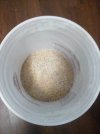My neighbor had this done, too. I think he told me something like $3K per pilon, so you actually got a pretty good deal at $20K. Sure makes future mods and updates a lot easier when things are flat, plumb, and level. NOTHING about this house mets any of those criteria. I don’t think the builder had a level, plumb bob, or square on his truck. If he did, none of it got scratched up on this build.Unfortunately, I did not take many pictures, but I can describe it.
There were 8 holes dug against the stem wall, 2 in the NW corner and the remainder along the west side. The footing was broken away, then a steel piling with a helical drive point was rotationally driven down using a Bobcat excavator. When a minimum depth of 5 feet was reached below the bottom of the stem wall, and a minimum pressure of 1500 psi, the piling was set. Atop the piling was placed a jack driven lift plate, with 4 of those getting an extra 2 foot wide angle iron. The jacks were cranked to lift the NW corner ~1.75 inches, with minor lifts of 1/4 to 1/2 inch for the rest. Guaranteed to maintain the lift and level.
Finally, new treated cedar piers replaced the old untreated piers, and the new piers are actually adjustable. So our floors are much more stable now. I had to partially dismantle about 40 feet of deck for them to have access - that was a PITA, but it was a good learning experience. I just got everything reassembled yesterday afternoon, and I know well that I am not the young man I used to be.
View attachment 27032View attachment 27033View attachment 27034
Edit:
Forgot to ask, but have you had those siding tiles tested for asbestos? They look an awful lot like siding from the 60’s made by DuPont. Not a problem as long as they’re left undisturbed. But VERY expensive for remediation if you ever elect to replace it.










